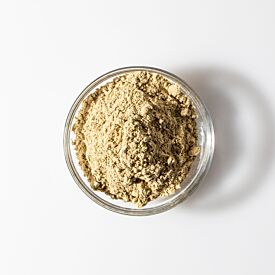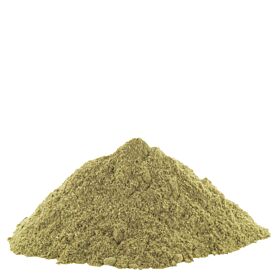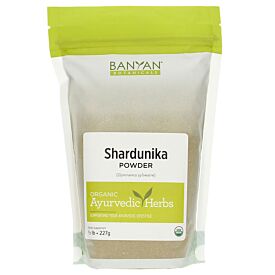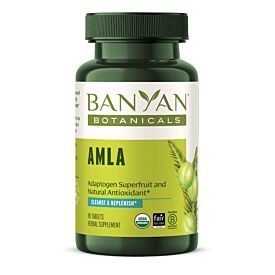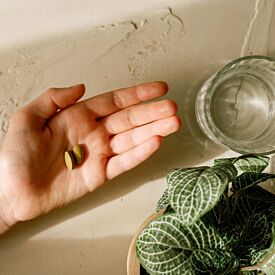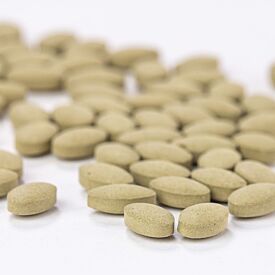Balancing Herbs for Healthy Sugar Metabolism
As we saw in the last article, healthy sugar metabolism requires optimal functioning of numerous organs and tissues which produce the hormones necessary to regulate glucose as fuel in the body: pancreas, liver, intestines, and nervous system. Bringing Ayurveda into the picture, kapha must primarily be balanced, supplying relief to any imbalanced vata and pitta, allowing for proper digestion, usage, and production of glucose in the body.
Ayurveda has a number of herbs that are beneficial in bringing balance to kapha and supporting the body’s natural sugar metabolism mechanisms. We’ll review several important ones here:
- Shardunika (Gymnema sylvestre): Also known as Gurmar, this classical herb has been used for ages, and its traditional name translates as “sugar destroyer”. The extract has been shown in studies to support the pancreas natural production of insulin,1 thereby helping glucose uptake from the bloodstream. Along with many of the herbs below, it is listed as one of the most useful plant species for sugar metabolism among 270 plants reviewed from South East Asia. 2 It is traditionally known for its capacity to reduce the ability to taste sweet as well as cravings for sweet taste. Astringent, pungent, and heating in nature, shardunika helps reduce kapha, calms the liver and pancreas, and targets the digestive and circulatory systems.
- Neem (Azadirachta indica): Neem is also beneficial for the pancreas and has been shown to support the growth of healthy beta cells (which produce insulin and amylin)4 and is also among the top plants for sugar metabolism in South East Asia. 2 It is thought that neem can help support the body’s natural insulin signaling mechanisms as well as normal glucose usage by skeletal muscle. 5 Neem’s bitter taste and pungent vipaka (post-digestive effect) make it a powerful purifier and detoxifier, targeting the blood and fat tissues, and useful wherever a “reduction program is indicated”. 3
- Guduchi (Tinospora cordifolia): Used for ages for sugar metabolism by Ayurveda, guduchi has also been shown over time to be included in the most useful plants from Southeast Asia,2 improving glucose tolerance and decreasing circulating glucose. 1 An active ingredient isolated from guduchi has also been shown to improve glucose levels and support beta cell regeneration. 6 Guduchi, while known for being a pitta tonic, is balancing for all three doshas; it has a bitter, astringent, and sweet taste that also targets the circulatory and digestive systems and the fat tissue, and its hot nature is able to remove natural toxins without aggravating pitta. 3
- Turmeric (Curcuma longa): Known for its wide range of uses, turmeric is especially helpful in maintaining healthy sugar metabolism. 2, 7 It is thought that perhaps turmeric’s support of the body’s natural anti-oxidant mechanisms as well as other molecular pathways helps support healthy glucose levels. 8 Its pungent, bitter, and heating nature help detoxify and balance kapha, while supporting the digestion and the pancreas. 3
- Amalaki (Emblica officinalis): This Ayurvedic superfruit is also shown in multiple studies to support the natural function of the pancreas while also helping the body’s sensitivity to uptake glucose from the bloodstream. 9, 10, 11 From our review of the organs involved in healthy hormone production for glucose metabolism, it is also apparent that healthy intestines are needed to support this function; amalaki’s support of natural anti-oxidant mechanisms and colon health could also benefit the body’s sugar metabolism. It is balancing for all three doshas, and therefore helps kapha while keeping vata and pitta in check as well.
- Shilajit: This mineral pitch is highly renowned in Ayurveda for its abilities to balance kapha and the metabolism. Studies have shown that it is useful in helping the body maintain better glucose levels. 12 As a rasayana, shilajit is considered by Ayurveda to support healthy pancreatic cells and natural anti-oxidant mechanisms. 13 Its astringent, pungent, bitter, and warm nature helps balance kapha as well as vata.
In addition to the herbs listed above, adding cinnamon and fenugreek seeds to the diet can also be beneficial in supporting the body’s natural glucose metabolism. For an easy way to incorporate the herbs listed above into your client’s regimen, you can find all these herbs (except shilajit) in Banyan’s Sweet Ease tablets, and if needed, Shilajit tablets can also be added to the regimen. Your clients will appreciate a more balanced glucose metabolism as it will support their energy levels, immune system, and mental clarity.
References
1 Khan, Vasim et al. A pharmacological appraisal of medicinal plants with antidiabetic potential. J Pharm Bioallied Sci. 2012 Jan-Mar; 4(1): 27–42.
2 Marwat, SK et al. Useful ethnophytomedicinal recipes of angiosperms used against diabetes in South East Asian Countries (India, Pakistan, and Sri Lanka). Pak J Pharm Sci. 2014 Sep; 27(5):1333-58.
3 Frawley, David and Lad, Vasant. The Yoga of Herbs. Lotus Press: 1986. 164, 170, 205-6, 230-233,
4 McCalla G, et all. Beta cell regenerating potential of azadirachta indica (neem) in diabetic rats. West Indian Med J. 2015 May 5.
5 http://www.ncbi.nlm.nih.gov/pubmed/26604551
6 Rajalakshmi M et al. B-cell regenerative efficacy of a polysaccharide isolated from methanolic extract of Tinospora cordifolia stem on Streptozotocin-induced diabetic Wistar rats. Chem Biol Interact. 2016 Jan 5; 243: 45-53.
7 http://www.ncbi.nlm.nih.gov/pubmed/26826833
8 Nabavi, SF et al. Curcumin: a natural product for diabetes and its complications. Curr Top Med Chem. 2015;15(23):2445-55.
9 http://www.ncbi.nlm.nih.gov/pubmed/22329631
10 http://www.ncbi.nlm.nih.gov/pubmed/24696584
11 http://www.ncbi.nlm.nih.gov/pubmed/26593435
12 Trivedi, NA et al. Effect of shilajit on blood glucose and lipid profile in alloxan-induced diabetic rats. Indian Journal of Pharmacology. 2004: 36 (6): 373-76.
13 http://care.diabetesjournals.org/content/26/8/2469.2.full



